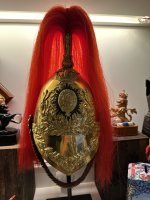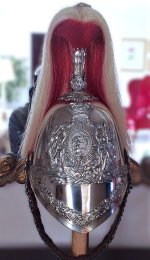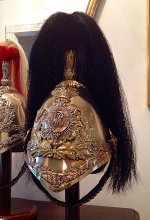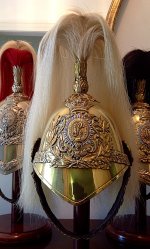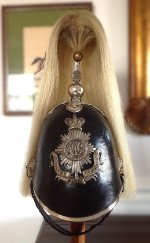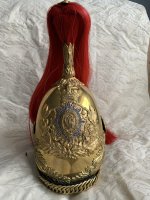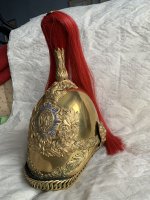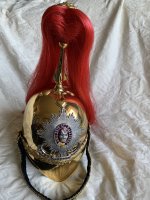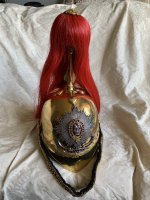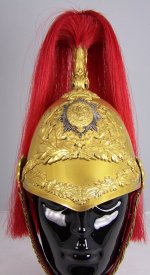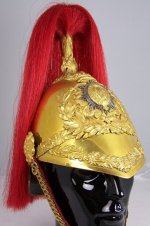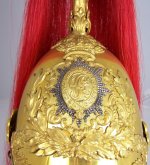Hello Dan.
First let me tell what a lovely helmet you have, very nice. I will attempt to answer your questions in the order you have asked them.
1, The star on your helmet has toned, a term most closely associated with describing silver coins... it has tarnished. Without disassembling the helmet plate, which I do not recommend, it will be very difficult to clean the star as the blackened patina is very stubborn to remove, and you run the risk of rubbing off or removing the silver plate and damaging/rubbing away the very, very thin gilt on the center regimental title strap and surrounding recco shield revealing the base metal beneath the gilt.
2. The size of the star behind the regimental title strap varied as British dragoon helmets evolved from the 1848 pattern to the 1871 pattern helmet. Even though Dragoon and Dragoon Guards helmets circa 1855 were similar to those helmets worn by the two regiments of Life Guards and the one regiment of Horse Guards, Life Guards and Horse Guards helmets were of their own distinctive pattern and shouldn't be compared to the line regiments of Dragoons and Dragoon Guards as there are nuances in pattern of the two.
3. Your red plume is correct for the 1st Kings Dragoon Guards post Crimean War period. How ever, from what I can tell from your photograph the plume on your helmet appears to be of incorrect pattern. It appears to be the later pattern 1871 plume. The correct plume for this helmet would include an upright brush at the base of the plume similar in appearance to shaving cream application brush. Prior to approximately mid1856 all regiments of Dragoons and Dragoon Guards wore black plumes with the up-right brush at the base (the original 1848 pattern plume). Those regiments of Dragoons on service in the Crimea did not display/wear their plumes in the field in that theater of operations. In mid-1856 the various regiment adopted the more familiar plume colors scene on the 1871 pattern plumes; 1st DG, red; 2nd DG black; 3rd DG black over red; 4th DG white; 5th DG white over red; 6th DG white; 7th DG black over white; 1st D black; 2nd D bearskin busby; 6th D white, but were still of the 1848 pattern with the up=right brush until 1871.
4. The most obvious external indication of officer vice other-ranks helmets is the finish to the helmet, officers being gilt or silver depending on Dragoon Guards or Dragoons and other-ranks being brass or white metal/German silver. The interior linings for officers' helmet and other-ranks helmets are also dramatically different, officers' helmets typically having a fine glove leather and silk lining and trooper's helmets a rough leather "finger like" liner. Also, the plume holder is longer/taller on officer's helmets when compared to those of other-rank helmets.
I have included several pictures of 1848 pattern helmets I have in my collection to give you a better idea of what the correct pattern plume should look like for your helmet. I hope this is helpful and answers your questions.
Cheers,
David
View attachment 60435
One of three 1848 pattern officer's helmets made to the 1st Lancashire Mounted Rifle Volunteers worn 1860-1861
View attachment 60436
An 1848 pattern officer's helmet to the 6th Dragoon Guards (Carabiners)
View attachment 60437
An officer-s 1848 pattern helmet transitioning to the plainer 1871 pattern helmet to the Suffolk Yeomanry Cavalry. note: The helmet is devoid of the filigree on the front and rear peaks and shows the correct 1848 patten plume with the up-right brush at the base of the plume and as seen in the helmet right and behind, the 1st Lancashire Mounted Rifle helmet.
View attachment 60438
A circa 1850 pattern black leather officer's helmet to the Prince Albert's Own Leicestershire Yeomanry Cavalry. This helmet was worn by this regiment until 1870 with a black plume prior to 1868 then white from 1868 to 1870. Again, this shows to good advantage the correct pattern plume for the 1st King's Dragoon Guards 1848 pattern helmet.
